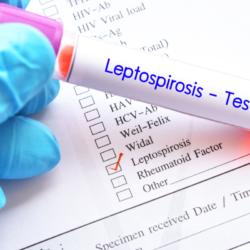Tuberculosis is a chronic infectious disease that affects many animal species, including humans. This zoonosis, caused by bacteria of the genus Mycobacterium, is a major public and veterinary health issue. Understanding the mechanisms of infection, modes of transmission, symptoms and possible treatments is crucial in the fight against this disease.
What is the infectious agent responsible?
Bovine tuberculosis is an infectious disease transmissible to humans, caused mainly by the bacterium Mycobacterium bovis (M. bovis). This bacterium, which belongs to the mycobacteria family, can infect a wide variety of domestic and wild species, including cattle, deer, wild boar, badgers and foxes. Other mycobacteria involved in tuberculosis include M. tuberculosis, responsible for human tuberculosis, and the less common M. africanum.
Mycobacterium bovis, the main cause of ruminant tuberculosis, is particularly adapted to domestic and wild ruminants. This bacterium is strictly aerobic, meaning it requires oxygen to survive and develop. It grows slowly, with a reproduction cycle of 16 to 20 hours to produce one generation.
M. bovis has a complex cell wall structure. It is composed of polymers and mycolic acids, making it resistant to many chemical and physical agents. In particular, it is resistant to ordinary dyes and to Gram. The Ziehl-Neelsen method is used for staining. This method distinguishes acid-fast bacilli (AFB ) by staining them pink on a blue background.
Mycobacterium tuberculosis shares 99.95% genetic similarity with M. bovis. This similarity makes differentiation crucial for diagnosis and treatment. However, M. bovis has a slightly smaller genome. It has differences in gene expression. These differences concern in particular those involved in cell wall construction and metabolism.
Genomics research sequenced the entire M. bovis genome in 2003. This revealed extensive coding capabilities for cell wall components and certain secreted proteins. This information remains crucial for understanding host-bacteria interactions. It explains the immune evasion mechanisms that enable the bacterium to evade the host’s defences.
How does this disease manifest itself in animals?
Bovine tuberculosis can infect all animal species, including domestic and wild animals. Mycobacterium bovis mainly infects cattle, while M. tuberculosis mainly infects humans. Although France has been officially free of bovine tuberculosis since 2001, the disease persists in certain regions in wild cervids.
Infected animals, whether sick or not, can transmit the bacterium by several routes.Inhalation of contaminated droplets, released when coughing, is a common route of transmission.In addition, ingestion of contaminated milk, drinking water or fodder can also transmit the disease. Wounds caused by contaminated objects, such as feeding utensils or troughs, are also potential vectors.
The symptoms of tuberculosis in animals are not very specific and vary according to the location of the infection. The most commonly infected domestic ruminants include cattle, goats and sheep. In France, after decades of combating the disease, it has become rare in these domestic species, but persists in certain residual or re-emerging outbreaks.
Tuberculosis is a chronic disease, and infected animals rarely present characteristic symptoms. However, their general condition may deteriorate, with signs such as emaciation and reduced production. Lesions suggestive of infection are often only discovered at autopsy or during post-slaughter health inspection.
Macroscopic lesions of tuberculosis often appear in the thoracic lymph nodes of cattle. They may also involve the retropharyngeal, parotid, tracheobronchial, mediastinal and pulmonary tissues. In domestic carnivores, such as dogs and cats, diagnosis is difficult. Special care is needed to prevent them from becoming epidemiological relays.
How is it transmitted?
Tuberculosis can be transmitted in several ways, affecting both humans and animals. M. bovis is mainly transmitted via the respiratory route, by inhaling contaminated aerosols emitted by infected animals. Infected animals, whether symptomatic or not, can excrete the bacteria into the environment through their secretions, such as sputum,urine and faeces.
Direct contact with infected animals or their corpses is also a route of transmission. Professionals in frequent contact with animals, such as vets, abattoir workers and livestock farmers, are particularly at risk. Contamination can occur through inhalation of infected aerosols, ingestion of contaminated products, or injury from contaminated objects.
As far as humans are concerned, Mycobacterium bovis tuberculosis of animal origin is relatively rare, but it can occur following the ingestion of raw milk or unpasteurised dairy products from infected animals. In France, human cases of tuberculosis are mainly due to M. tuberculosis, but cases of zoonotic tuberculosis have been reported.
Occupational activities with a high risk of transmission include work in livestock farms, abattoirs and rendering plants. A prolonged stay in a contaminated environment or handling infected cadavers can be enough to infect a person. Immunocompromised people, such as those living with HIV, are particularly vulnerable to tuberculosis.
The survival of M. bovis in the environment, coupled with its multiple routes of transmission, makes the prevention of this zoonosis complex. The fight against bovine tuberculosis involves strict health control measures, pasteurisation of dairy products and rigorous farm management practices.
What are the symptoms of this infection in humans?
M. bovis tuberculosis in humans mainly manifests itself as extrapulmonary infections, particularly affecting the kidneys. Initially, the disease is often asymptomatic, but it progresses with symptoms such as moderate fever, general fatigue and weight loss. Specific symptoms depend on the location of the infection.
Localised forms of tuberculosis can occur as a result of accidental inoculation, particularly in exposed workers, and manifest themselves as lymph node or joint involvement. Pulmonary tuberculosis, caused mainly by M. tuberculosis, is characterised by a persistent cough, chest pains and sometimes bloody sputum.
Immunocompromised individuals, particularly those infected with HIV, are at increased risk of developing active tuberculosis. The association between tuberculosis and HIV is particularly dangerous, with each infection accelerating the progression of the other. People with untreated TB and HIV risk a high mortality rate.
Common symptoms of TB include a prolonged cough, chest pain, intense fatigue and night sweats. The disease can also affect other organs, such as the kidneys, brain, spine and skin, causing site-specific symptoms. For example, lymph node tuberculosis causes swelling of the lymph nodes, while bone tuberculosis causes joint and back pain.
Genitourinary tuberculosis, which is often sexually transmitted, manifests itself as genital ulcers and urinary symptoms. Gastrointestinal and cutaneous tuberculosis are rarer but can occur, causing various symptoms depending on the location of the infection.
How is it diagnosed?
Diagnosis of tuberculosis is based on a combination of clinical, radiological and microbiological methods. The first stage of diagnosis generally involves a clinical assessment of the patient’s symptoms and medical history.
One of the main diagnostic methods is the tuberculin skin test (TST), also known as the Mantoux test. This test involves injecting a small amount of tuberculin under the skin of the forearm. An indurated skin reaction after 48 to 72 hours indicates previous exposure to Mycobacterium tuberculosis. However, this test does not distinguish between latent infection and active disease, and can give false positive results in people vaccinated with BCG.
Healthcare professionals use blood tests, such as interferon gamma release assays (IGRA), to detect tuberculosis infection. These tests measure the immune response to the presence of M. tuberculosis in the blood. They are particularly useful for people who have received the BCG vaccine, as they do not produce false positives. IGRAs are often preferred for their accuracy and speed.
To confirm the diagnosis, microbiological tests such as sputum culture and Ziehl-Neelsen staining are carried out. Sputum culture detects the presence of live bacteria, but can take several weeks due to the slow growth rate of M. tuberculosis. Ziehl-Neelsen staining reveals the acid-fast bacilli typical of M. tuberculosis. Chest X-rays are frequently used to identify the characteristic pulmonary lesions of tuberculosis, such as cavities and infiltrates.
More advanced methods, such as PCR (polymerase chain reaction), rapidly detect M. tuberculosis DNA. They offer a faster, more accurate diagnosis. Analysis of body fluids such as cerebrospinal fluid,urine or tissue biopsies may be necessary for extrapulmonary forms of tuberculosis.
What is the appropriate treatment?
Tuberculosis is treated with a combination of specific antibiotics. These drugs are administered over a prolonged period to eliminate the bacteria. The standard treatment regimen for active tuberculosis begins with an initial two-month phase. This phase includes four antibiotics: isoniazid, rifampicin, pyrazinamide and ethambutol. This is followed by a continuation phase of four to seven months with isoniazid and rifampicin.
Isoniazid is a bacteriostatic agent that inhibits the synthesis of mycolic acids, which are essential to the cell wall of mycobacteria. Rifampicin acts by inhibiting bacterial RNA polymerase, thereby blocking the transcription of DNA into RNA. Pyrazinamide is particularly effective in the acidic environments of infected macrophages, where it disrupts the bacteria’s energy metabolism. Finally, ethambutol inhibits the synthesis of arabinogalactan, a key component of the bacterial cell wall.
In cases of multidrug-resistant tuberculosis (MDR-TB), second-line drugs such as kanamycin, capreomycin and fluoroquinolones are used. The treatment of MDR-TB takes longer and has more side effects, requiring close medical supervision. Patients often require treatment for 18 to 24 months, and cure rates are generally lower than for drug-susceptible TB.
In addition to medication, tuberculosis treatment requires rigorous monitoring and strict compliance with treatment. Interruption of treatment or irregular intake of medication can lead to drug resistance, making the disease more difficult to treat. DOT (Directly Observed Treatment) programmes are often used to ensure that patients take their medication correctly.
What preventive measures are available?
Tuberculosis prevention is based on several key strategies aimed at reducing transmission of the disease and protecting at-risk populations. Vaccination with BCG (Bacille Calmette-Guérin) is one of the most commonly used methods of prevention. This vaccine is particularly effective in preventing severe forms of tuberculosis in children.
Collective prevention measures include improving living conditions in areas with a high incidence of tuberculosis. Tuberculosis prevention includes several strategies to reduce transmission. Adequate ventilation of living spaces remains essential. Overcrowding in homes and workplaces must also be reduced. Improving general hygiene also contributes to prevention.
Systematic screening programmes and early treatment of active cases play a crucial role. They significantly reduce the spread of the disease. In addition, awareness and education campaigns inform the public. They explain modes of transmission and protective measures.
Individual prevention measures include the use of face masks. Tuberculosis patients must wear them to prevent the spread of infectious droplets.Temporary isolation of contagious patients is necessary until they are no longer contagious. Contacts of infected people should be monitored regularly for signs of illness.
Healthcare professionals must follow strict infection control protocols. This includes the use of personal protective equipment. They must also apply infection prevention and control measures in healthcare establishments.
Antibiotic prophylaxis is another important preventive strategy, particularly for people with latent tuberculosis who are at high risk of developing active tuberculosis.
Some epidemiological data
Tuberculosis remains a global threat, particularly in low- and middle-income countries. According to data from the World Health Organisation (WHO), around 10 million people will have developed tuberculosis in 2022. In addition, there will be 1.5 million deaths due to tuberculosis. This makes it one of the leading causes of infectious death in the world.
South-East Asia and sub-Saharan Africa are the regions most affected, with a particularly high incidence in India, Indonesia and South Africa. These countries account for almost 60% of tuberculosis cases worldwide. In addition, co-infection with HIV significantly increases the risk of developing active tuberculosis. Around 8% of tuberculosis cases in 2022 will involve people living with HIV. This interaction between HIV and tuberculosis is of particular concern in regions where both infections are endemic.
Multidrug-resistant tuberculosis (MDR-TB) is a growing threat to global public health. Around 500,000 new cases of MDR-TB have been estimated for 2022. Cure rates for MDR-TB are significantly lower than those for drug-susceptible TB. This underlines the importance of strengthening treatment and prevention strategies. The regions most affected by MDR-TB include Eastern Europe, Central Asia and parts of Africa.
Global efforts to combat TB include initiatives such as the WHO’s End TB strategy. This aims to reduce TB deaths by 90% and incidence by 80% by 2030. This strategy focuses on improving early detection, effective treatment and preventing the transmission of tuberculosis. Progress in research into new vaccines, diagnostics and treatments is also crucial to achieving these goals.





